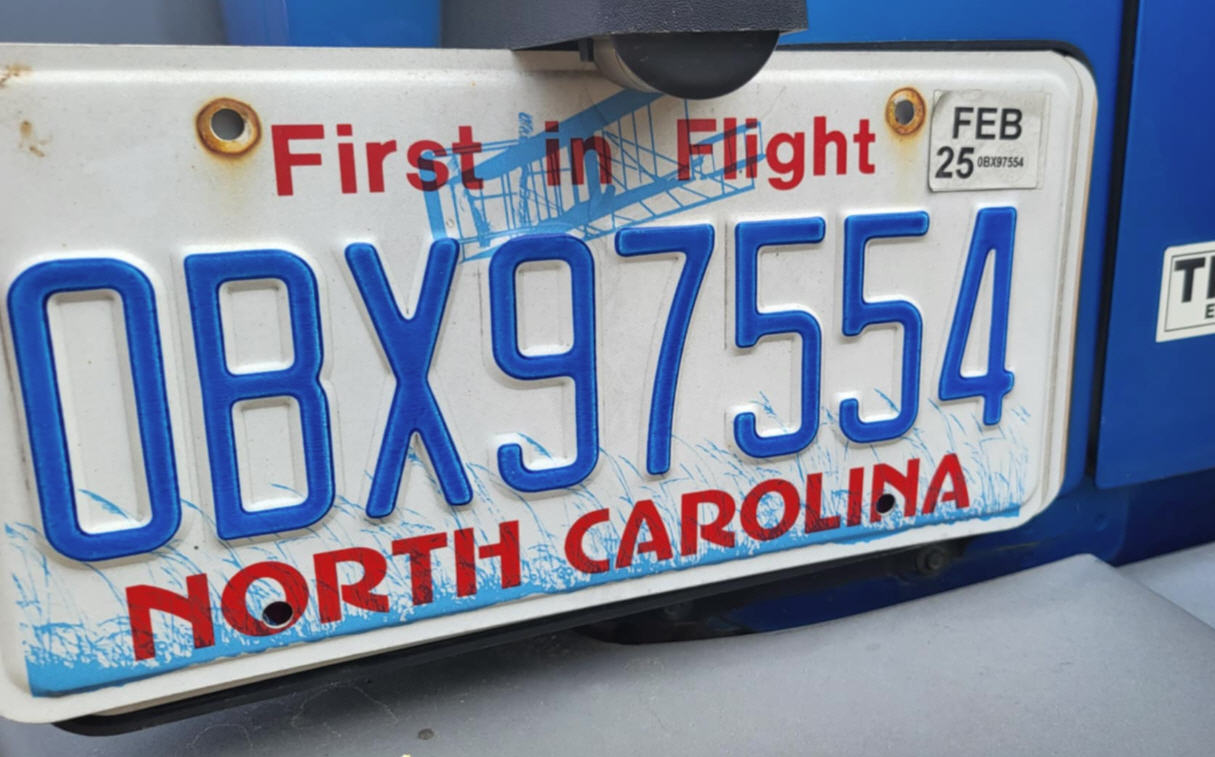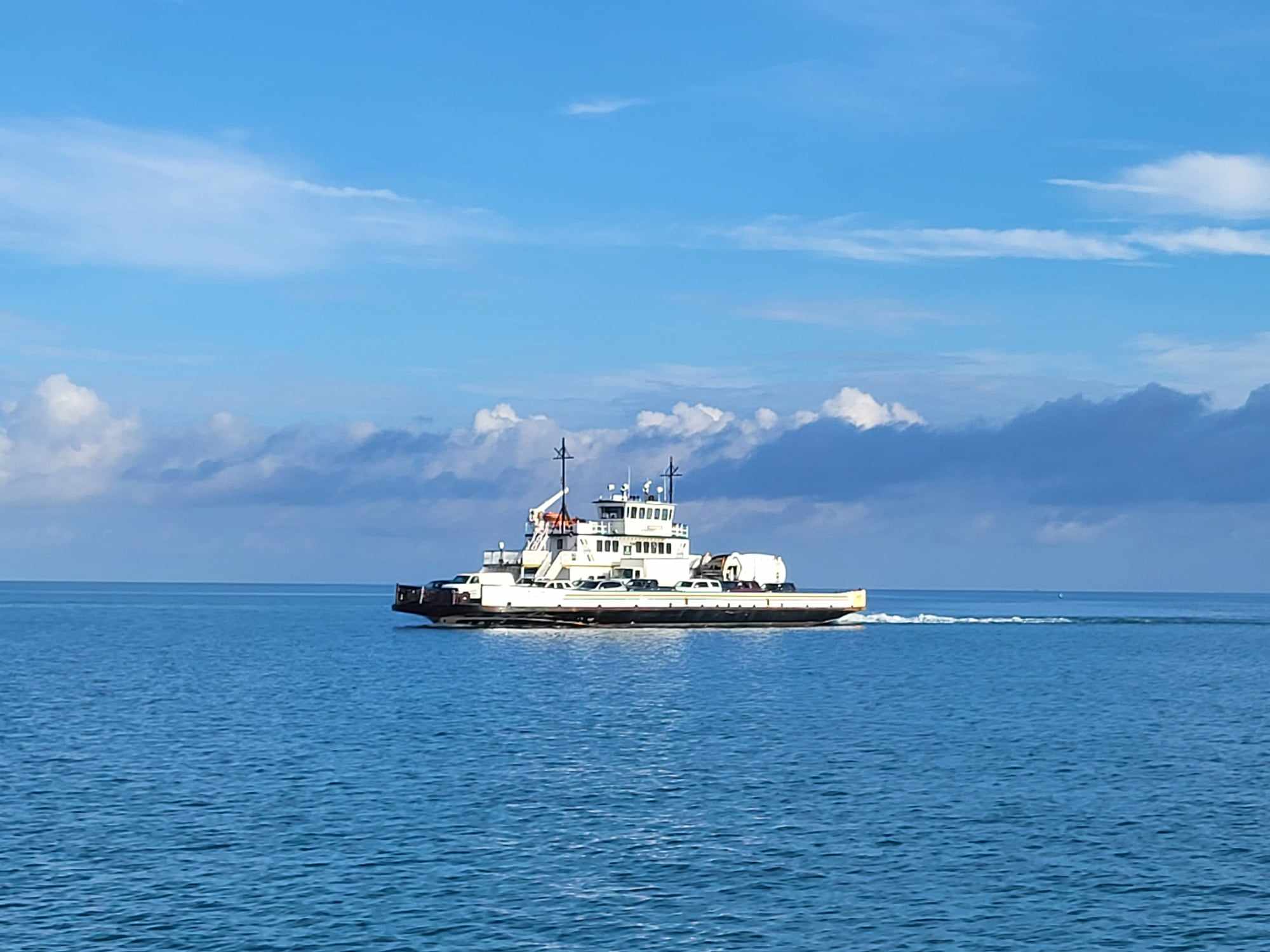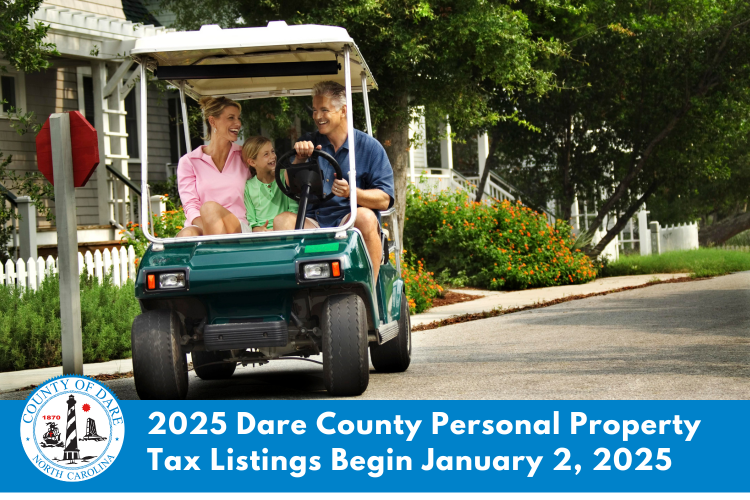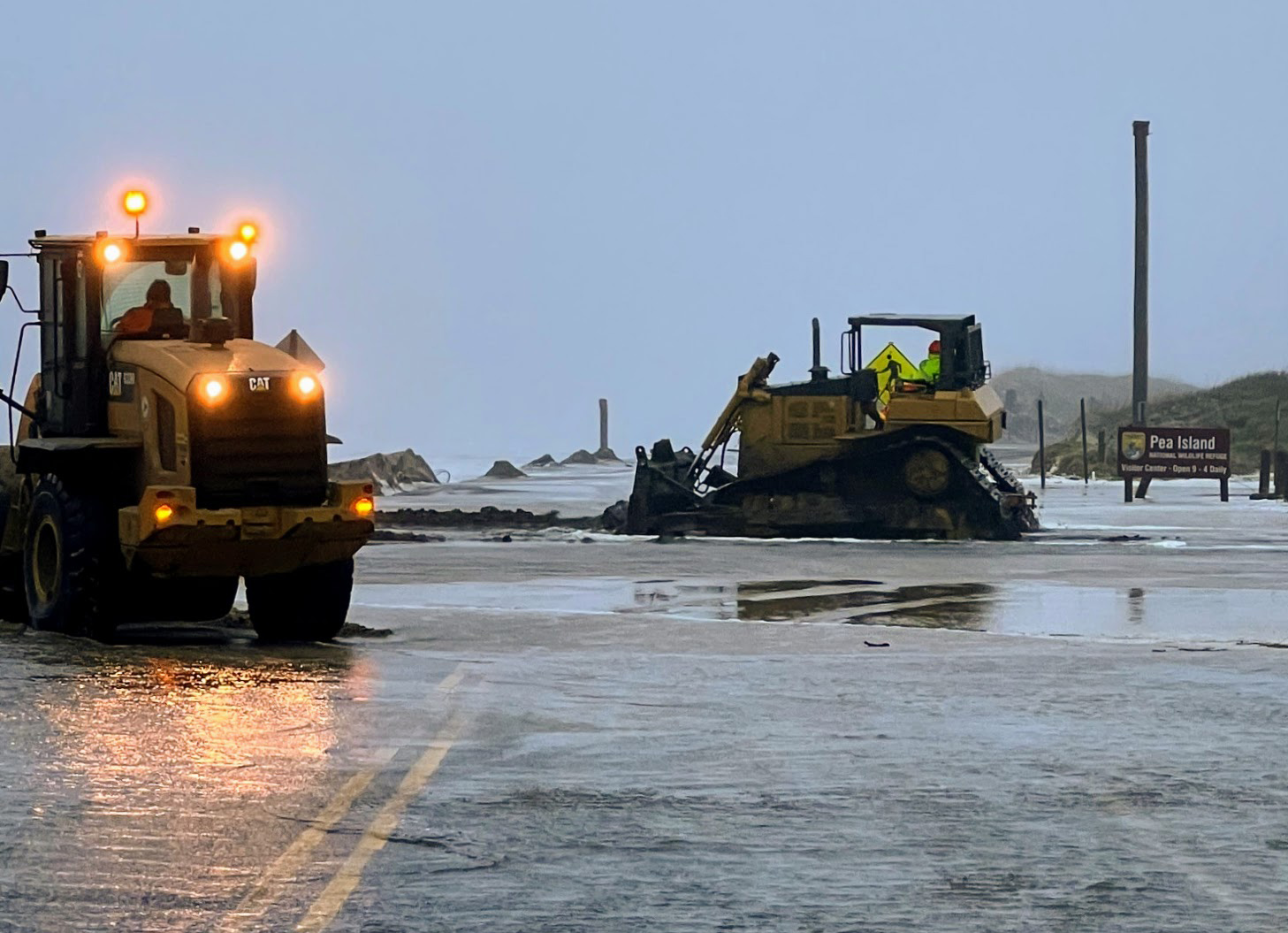By IRENE NOLAN
UPDATE:
By IRENE NOLAN
By IRENE NOLAN
By IRENE NOLAN
By IRENE NOLAN
Piping plovers nesting at the Cape Hatteras National Seashore is about what it was this time last year, according to the National Park Service’s weekly Resource Management Summary for June 13.
There have been 18 piping plover nests to date, which was the total for all of 2011.
Britta Muiznieks, Park Service biologist, said that there may still be a couple more nests before this year’s nesting season ends.
So far two piping plover chicks have fledged, the same number as had fledged in last year’s June 15 report.
Both fledged chicks were from one nest at Cape Point. Last year’s two fledged chicks at this time included one each from two different Cape Point nests.
There have been a total of 10 nests at Cape Point this year, which is twice the five that were reported for last year. However, four of those nests have been lost to “unknown causes,” Muiznieks said.
In addition to the nest that hatched, as of yesterday, there are still four active nests and one active brood in the Cape Point area.
Last year, seven chicks fledged from the five nests at Cape Point.
There is also one active nest on South Beach, just south of Cape Point. Last year, there were two nests. One nest was lost, and one hatched but the chicks were lost to unknown causes.
There has been one nest on Bodie Island this year, which was lost to unknown causes. Last year there were two nests and two chicks fledged.
On North Ocracoke, there has been one nest, the same as last year. This year the nest was lost to unknown causes, while last year, the nest hatched and the chicks were lost.
South Point on Ocracoke has had five nests this year, and all have been lost.
Muiznieks said one nest was lost to overwash as Tropical Storm Beryl passed off the coast, one was lost to probably mink predation, and the others were lost to unknown causes. The Park Service had a camera on one South Point nest. Biologists know the nest hatched but never saw the chicks.
Last year, there were eight piping plover nests at South Point, but only one chick fledged.
This year, there are two Wilson’s plovers nesting on the seashore, one at Cape Point and one at South Point on Ocracoke. Muiznieks said it’s the first known instance of a Wilson’s plover nesting at Cape Point.
Last year, there was one Wilson’s plover nest by this time at South Point, but no chicks were fledged.
Sea turtle nesting is way ahead of this time last year.
So far, there are 56 nests on the seashore – 43 on Hatteras and 13 on Ocracoke.
In last year’s June 15 resource summary, there were only 38 nests.
False crawls are 40 so far this year, compared to 30 on June 15 of last year.
Muiznieks said it’s unclear at this point whether the turtles are just nesting earlier or if there will be many more nests than last year’s total of 147.
So far this year, there have been 29 American oystercatcher nests counted – two on Bodie Island, one on Green Island, 20 on Hatteras and six on Ocracoke. There are six active nests and 11 active broods.
Last year this time, there were five active nests and 16 active broods.
There are 13 colonial waterbird colonies on the seashore, which is down just two from this time last year.
One of the colonies is on Bodie Island, one is on Green Island, nine are on Hatteras, and two are on Ocracoke.
This year’s weekly Resource Management Reports are streamlines — much briefer and with considerably less information than last year — which makes it somewhat more difficult to make comparisons.
You can find this year’s weekly reports in the red bar at the top of the Beach Access and Park Issues Page, and previous years’ reports on archived on the Archives Page. Click on the bar toward the bottom of the front page.
The 2011 Park Service annual resource report can be found at: http://islandfreepress.org/2012Archives/02.09.2012-ParkServiceIssuesAnnualResourceLawEnforcementReports.html
Piping plovers nesting at the Cape Hatteras National Seashore is about what it was this time last year, according to the National Park Service’s weekly Resource Management Summary for June 13.
There have been 18 piping plover nests to date, which was the total for all of 2011.
Britta Muiznieks, Park Service biologist, said that there may still be a couple more nests before this year’s nesting season ends.
So far two piping plover chicks have fledged, the same number as had fledged in last year’s June 15 report.
Both fledged chicks were from one nest at Cape Point. Last year’s two fledged chicks at this time included one each from two different Cape Point nests.
There have been a total of 10 nests at Cape Point this year, which is twice the five that were reported for last year. However, four of those nests have been lost to “unknown causes,” Muiznieks said.
In addition to the nest that hatched, as of yesterday, there are still four active nests and one active brood in the Cape Point area.
Last year, seven chicks fledged from the five nests at Cape Point.
There is also one active nest on South Beach, just south of Cape Point. Last year, there were two nests. One nest was lost, and one hatched but the chicks were lost to unknown causes.
There has been one nest on Bodie Island this year, which was lost to unknown causes. Last year there were two nests and two chicks fledged.
On North Ocracoke, there has been one nest, the same as last year. This year the nest was lost to unknown causes, while last year, the nest hatched and the chicks were lost.
South Point on Ocracoke has had five nests this year, and all have been lost.
Muiznieks said one nest was lost to overwash as Tropical Storm Beryl passed off the coast, one was lost to probably mink predation, and the others were lost to unknown causes. The Park Service had a camera on one South Point nest. Biologists know the nest hatched but never saw the chicks.
Last year, there were eight piping plover nests at South Point, but only one chick fledged.
This year, there are two Wilson’s plovers nesting on the seashore, one at Cape Point and one at South Point on Ocracoke. Muiznieks said it’s the first known instance of a Wilson’s plover nesting at Cape Point.
Last year, there was one Wilson’s plover nest by this time at South Point, but no chicks were fledged.
Sea turtle nesting is way ahead of this time last year.
So far, there are 56 nests on the seashore – 43 on Hatteras and 13 on Ocracoke.
In last year’s June 15 resource summary, there were only 38 nests.
False crawls are 40 so far this year, compared to 30 on June 15 of last year.
Muiznieks said it’s unclear at this point whether the turtles are just nesting earlier or if there will be many more nests than last year’s total of 147.
So far this year, there have been 29 American oystercatcher nests counted – two on Bodie Island, one on Green Island, 20 on Hatteras and six on Ocracoke. There are six active nests and 11 active broods.
Last year this time, there were five active nests and 16 active broods.
There are 13 colonial waterbird colonies on the seashore, which is down just two from this time last year.
One of the colonies is on Bodie Island, one is on Green Island, nine are on Hatteras, and two are on Ocracoke.
This year’s weekly Resource Management Reports are streamlines — much briefer and with considerably less information than last year — which makes it somewhat more difficult to make comparisons.
You can find this year’s weekly reports in the red bar at the top of the Beach Access and Park Issues Page, and previous years’ reports on archived on the Archives Page. Click on the bar toward the bottom of the front page.
The 2011 Park Service annual resource report can be found at: http://islandfreepress.org/2012Archives/02.09.2012-ParkServiceIssuesAnnualResourceLawEnforcementReports.html
Piping plovers nesting at the Cape Hatteras National Seashore is about what it was this time last year, according to the National Park Service’s weekly Resource Management Summary for June 13.
There have been 18 piping plover nests to date, which was the total for all of 2011.
Britta Muiznieks, Park Service biologist, said that there may still be a couple more nests before this year’s nesting season ends.
So far two piping plover chicks have fledged, the same number as had fledged in last year’s June 15 report.
Both fledged chicks were from one nest at Cape Point. Last year’s two fledged chicks at this time included one each from two different Cape Point nests.
There have been a total of 10 nests at Cape Point this year, which is twice the five that were reported for last year. However, four of those nests have been lost to “unknown causes,” Muiznieks said.
In addition to the nest that hatched, as of yesterday, there are still four active nests and one active brood in the Cape Point area.
Last year, seven chicks fledged from the five nests at Cape Point.
There is also one active nest on South Beach, just south of Cape Point. Last year, there were two nests. One nest was lost, and one hatched but the chicks were lost to unknown causes.
There has been one nest on Bodie Island this year, which was lost to unknown causes. Last year there were two nests and two chicks fledged.
On North Ocracoke, there has been one nest, the same as last year. This year the nest was lost to unknown causes, while last year, the nest hatched and the chicks were lost.
South Point on Ocracoke has had five nests this year, and all have been lost.
Muiznieks said one nest was lost to overwash as Tropical Storm Beryl passed off the coast, one was lost to probably mink predation, and the others were lost to unknown causes. The Park Service had a camera on one South Point nest. Biologists know the nest hatched but never saw the chicks.
Last year, there were eight piping plover nests at South Point, but only one chick fledged.
This year, there are two Wilson’s plovers nesting on the seashore, one at Cape Point and one at South Point on Ocracoke. Muiznieks said it’s the first known instance of a Wilson’s plover nesting at Cape Point.
Last year, there was one Wilson’s plover nest by this time at South Point, but no chicks were fledged.
Sea turtle nesting is way ahead of this time last year.
So far, there are 56 nests on the seashore – 43 on Hatteras and 13 on Ocracoke.
In last year’s June 15 resource summary, there were only 38 nests.
False crawls are 40 so far this year, compared to 30 on June 15 of last year.
Muiznieks said it’s unclear at this point whether the turtles are just nesting earlier or if there will be many more nests than last year’s total of 147.
So far this year, there have been 29 American oystercatcher nests counted – two on Bodie Island, one on Green Island, 20 on Hatteras and six on Ocracoke. There are six active nests and 11 active broods.
Last year this time, there were five active nests and 16 active broods.
There are 13 colonial waterbird colonies on the seashore, which is down just two from this time last year.
One of the colonies is on Bodie Island, one is on Green Island, nine are on Hatteras, and two are on Ocracoke.
This year’s weekly Resource Management Reports are streamlines — much briefer and with considerably less information than last year — which makes it somewhat more difficult to make comparisons.
You can find this year’s weekly reports in the red bar at the top of the Beach Access and Park Issues Page, and previous years’ reports on archived on the Archives Page. Click on the bar toward the bottom of the front page.
The 2011 Park Service annual resource report can be found at: http://islandfreepress.org/2012Archives/02.09.2012-ParkServiceIssuesAnnualResourceLawEnforcementReports.html
Piping plovers nesting at the Cape Hatteras National Seashore is about what it was this time last year, according to the National Park Service’s weekly Resource Management Summary for June 13.
There have been 18 piping plover nests to date, which was the total for all of 2011.
Britta Muiznieks, Park Service biologist, said that there may still be a couple more nests before this year’s nesting season ends.
So far two piping plover chicks have fledged, the same number as had fledged in last year’s June 15 report.
Both fledged chicks were from one nest at Cape Point. Last year’s two fledged chicks at this time included one each from two different Cape Point nests.
There have been a total of 10 nests at Cape Point this year, which is twice the five that were reported for last year. However, four of those nests have been lost to “unknown causes,” Muiznieks said.
In addition to the nest that hatched, as of yesterday, there are still four active nests and one active brood in the Cape Point area.
Last year, seven chicks fledged from the five nests at Cape Point.
There is also one active nest on South Beach, just south of Cape Point. Last year, there were two nests. One nest was lost, and one hatched but the chicks were lost to unknown causes.
There has been one nest on Bodie Island this year, which was lost to unknown causes. Last year there were two nests and two chicks fledged.
On North Ocracoke, there has been one nest, the same as last year. This year the nest was lost to unknown causes, while last year, the nest hatched and the chicks were lost.
South Point on Ocracoke has had five nests this year, and all have been lost.
Muiznieks said one nest was lost to overwash as Tropical Storm Beryl passed off the coast, one was lost to probably mink predation, and the others were lost to unknown causes. The Park Service had a camera on one South Point nest. Biologists know the nest hatched but never saw the chicks.
Last year, there were eight piping plover nests at South Point, but only one chick fledged.
This year, there are two Wilson’s plovers nesting on the seashore, one at Cape Point and one at South Point on Ocracoke. Muiznieks said it’s the first known instance of a Wilson’s plover nesting at Cape Point.
Last year, there was one Wilson’s plover nest by this time at South Point, but no chicks were fledged.
Sea turtle nesting is way ahead of this time last year.
So far, there are 56 nests on the seashore – 43 on Hatteras and 13 on Ocracoke.
In last year’s June 15 resource summary, there were only 38 nests.
False crawls are 40 so far this year, compared to 30 on June 15 of last year.
Muiznieks said it’s unclear at this point whether the turtles are just nesting earlier or if there will be many more nests than last year’s total of 147.
So far this year, there have been 29 American oystercatcher nests counted – two on Bodie Island, one on Green Island, 20 on Hatteras and six on Ocracoke. There are six active nests and 11 active broods.
Last year this time, there were five active nests and 16 active broods.
There are 13 colonial waterbird colonies on the seashore, which is down just two from this time last year.
One of the colonies is on Bodie Island, one is on Green Island, nine are on Hatteras, and two are on Ocracoke.
This year’s weekly Resource Management Reports are streamlines — much briefer and with considerably less information than last year — which makes it somewhat more difficult to make comparisons.
You can find this year’s weekly reports in the red bar at the top of the Beach Access and Park Issues Page, and previous years’ reports on archived on the Archives Page. Click on the bar toward the bottom of the front page.
The 2011 Park Service annual resource report can be found at: http://islandfreepress.org/2012Archives/02.09.2012-ParkServiceIssuesAnnualResourceLawEnforcementReports.html
Subject
Name
(required, will not be published)
(required, will not be published)
City :
State :
Your Comments:
May be posted on the Letters to the Editor page at the discretion of the editor.
May be posted on the Letters to the Editor page at the discretion of the editor.
May be posted on the Letters to the Editor page at the discretion of the editor.
May be posted on the Letters to the Editor page at the discretion of the editor.













